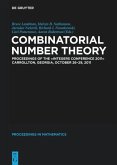The action of a compact Lie group, G, on a compact sympletic manifold gives rise to some remarkable combinatorial invariants. The simplest and most interesting of these is the moment polytope, a convex polyhedron which sits inside the dual of the Lie algebra of G. One of the main goals of this monograph is to describe what kinds of geometric information are encoded in this polytope. For instance, the first chapter is largely devoted to the Delzant theorem, which says that there is a one-one correspondence between certain types of moment polytopes and certain types of symplectic G-spaces. (One of the most challenging unsolved problems in symplectic geometry is to determine to what extent Delzant's theorem is true of every compact symplectic G-Space.)
The moment polytope also encodes quantum information about the actions of G. Using the methods of geometric quantization, one can frequently convert this action into a representations, p , of G on a Hilbert space, and in some sense the moment polytope is a diagrammatic picture of the irreducible representations of G which occur as subrepresentations of p. Precise versions of this item of folklore are discussed in Chapters 3 and 4. Also, midway through Chapter 2 a more complicated object is discussed: the Duistermaat-Heckman measure, and the author explains in Chapter 4 how one can read off from this measure the approximate multiplicities with which the irreducible representations of G occur in p. This gives an excuse to touch on some results which are in themselves of great current interest: the Duistermaat-Heckman theorem, the localization theorems in equivariant cohomology of Atiyah-Bott and Berline-Vergne and the recent extremely exciting generalizations of these results by Witten, Jeffrey-Kirwan, Lalkman, and others.
The last two chapters of this book are a self-contained and somewhat unorthodoxtreatment of the theory of toric varieties in which the usual hierarchal relation of complex tosymplectic is reversed. This book is addressed to researchers
The moment polytope also encodes quantum information about the actions of G. Using the methods of geometric quantization, one can frequently convert this action into a representations, p , of G on a Hilbert space, and in some sense the moment polytope is a diagrammatic picture of the irreducible representations of G which occur as subrepresentations of p. Precise versions of this item of folklore are discussed in Chapters 3 and 4. Also, midway through Chapter 2 a more complicated object is discussed: the Duistermaat-Heckman measure, and the author explains in Chapter 4 how one can read off from this measure the approximate multiplicities with which the irreducible representations of G occur in p. This gives an excuse to touch on some results which are in themselves of great current interest: the Duistermaat-Heckman theorem, the localization theorems in equivariant cohomology of Atiyah-Bott and Berline-Vergne and the recent extremely exciting generalizations of these results by Witten, Jeffrey-Kirwan, Lalkman, and others.
The last two chapters of this book are a self-contained and somewhat unorthodoxtreatment of the theory of toric varieties in which the usual hierarchal relation of complex tosymplectic is reversed. This book is addressed to researchers
"...carefully written book [on] the so-called Delzant spaces... Many of the statements in the body of the book are left as exercises (with copious hints). At the end of each chapter there are very interesting bibliographical notes. The reader who works through this book will acquire a solid knowledge of this beautiful and elegant part of mathematics." --Mathematical Reviews









